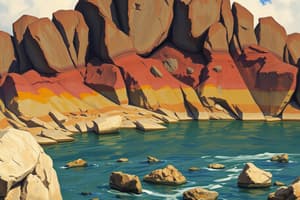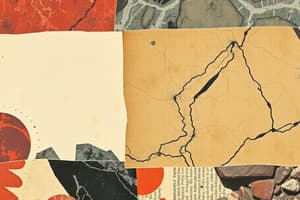Podcast
Questions and Answers
What is the carbon content of Lignite?
What is the carbon content of Lignite?
- 80%
- 30%
- 10%
- 45-60% (correct)
Which of the following is primarily used as a heating source in the form of briquettes?
Which of the following is primarily used as a heating source in the form of briquettes?
- Petroleum
- Peat (correct)
- Lignite
- Coal
What process leads to the formation of petroleum?
What process leads to the formation of petroleum?
- Decomposition of terrestrial plants
- Solidification of marine sediments
- Sublimation of hydrocarbons
- Burial of tiny sea plants and animals (correct)
Which energy source becomes hotter as you descend deeper into the Earth's crust?
Which energy source becomes hotter as you descend deeper into the Earth's crust?
What is the primary composition of coal?
What is the primary composition of coal?
What characteristic distinguishes foliated metamorphic rocks from non-foliated ones?
What characteristic distinguishes foliated metamorphic rocks from non-foliated ones?
Which type of coal is characterized by having the highest percentage of carbon?
Which type of coal is characterized by having the highest percentage of carbon?
Which process involves the transformation of organic plant matter into coal?
Which process involves the transformation of organic plant matter into coal?
Which of the following is an example of a non-foliated metamorphic rock?
Which of the following is an example of a non-foliated metamorphic rock?
What is a key feature of sedimentary rocks during their formation?
What is a key feature of sedimentary rocks during their formation?
What kind of metamorphism occurs due to intense heat and pressure over large areas?
What kind of metamorphism occurs due to intense heat and pressure over large areas?
Which factor is essential for the formation of fossil fuels from organisms?
Which factor is essential for the formation of fossil fuels from organisms?
Which of the following coal types has the lowest carbon percentage?
Which of the following coal types has the lowest carbon percentage?
What is the initial step in petroleum formation that involves the transformation of organic matter?
What is the initial step in petroleum formation that involves the transformation of organic matter?
What occurs during source rock subsidence?
What occurs during source rock subsidence?
At what depth does the temperature typically reach 100°C, facilitating kerogen transformation?
At what depth does the temperature typically reach 100°C, facilitating kerogen transformation?
Which type of organic debris typically produces more oil than gas?
Which type of organic debris typically produces more oil than gas?
What is the primary characteristic of reservoir rock that allows for fluid movement?
What is the primary characteristic of reservoir rock that allows for fluid movement?
What is the role of cap rock in the formation of hydrocarbon deposits?
What is the role of cap rock in the formation of hydrocarbon deposits?
Which process describes the movement of lighter hydrocarbons from source rock to reservoir rock?
Which process describes the movement of lighter hydrocarbons from source rock to reservoir rock?
Which of the following accurately describes the average geothermal flow on the surface?
Which of the following accurately describes the average geothermal flow on the surface?
What is the silica content range for intermediate rocks?
What is the silica content range for intermediate rocks?
Which type of rock is characterized by having more than 65% silica?
Which type of rock is characterized by having more than 65% silica?
What characteristic distinguishes ultra mafic rocks?
What characteristic distinguishes ultra mafic rocks?
Which of the following sedimentary processes involves the physical breakdown of rocks?
Which of the following sedimentary processes involves the physical breakdown of rocks?
What is the primary process that leads to the formation of stratification in sedimentary rocks?
What is the primary process that leads to the formation of stratification in sedimentary rocks?
Which feature is NOT commonly associated with sedimentary rocks?
Which feature is NOT commonly associated with sedimentary rocks?
Which of the following processes can contribute to weathering?
Which of the following processes can contribute to weathering?
In the context of sedimentary rocks, what does 'lamination' refer to?
In the context of sedimentary rocks, what does 'lamination' refer to?
What is the primary condition under which metamorphic rocks are formed?
What is the primary condition under which metamorphic rocks are formed?
Which type of metamorphism primarily involves heat and reactive fluids?
Which type of metamorphism primarily involves heat and reactive fluids?
Which of the following is true about coquina?
Which of the following is true about coquina?
Where are metamorphic rocks typically found?
Where are metamorphic rocks typically found?
What is a characteristic of foliated metamorphic rocks?
What is a characteristic of foliated metamorphic rocks?
Which of the following processes is involved in regional metamorphism?
Which of the following processes is involved in regional metamorphism?
What is the result of the anaerobic decomposition of plant remnants?
What is the result of the anaerobic decomposition of plant remnants?
What defines bioclastics such as coal and coquina?
What defines bioclastics such as coal and coquina?
Study Notes
Rock Types
- Felsic (Granitic): Light-colored, high silica content (over 65%)
- Major component of continental crust
- Intermediate (Andesitic): Medium-colored, 55-65% silica
- Associated with explosive volcanic activity
- Mafic (Basaltic): Dark-colored, 45-55% silica
- Denser than felsic rocks, comprises ocean floor and volcanic islands
- Ultramafic: Very dark-colored, less than 45% silica
- High magnesium and iron content
Sedimentary Rocks
- Formed at or near the Earth's surface under low pressure and temperature
- Key Characteristics:
- Stratification or layering: Distinct layers representing periods of deposition
- Bedding: Strata greater than 1 cm thick
- Lamination: Strata less than 1 cm thick
- Fossil assemblages: Preserved remains or traces of organisms
- Ripple marks: Formed by wind or water action, preserved in sedimentary rocks
- Stratification or layering: Distinct layers representing periods of deposition
- Weathering: Physical or chemical breakdown of rocks
- Frost wedging: Freezing and thawing of water in rocks
- Root wedging: Plants/roots growing into rocks
- Exfoliation: Outer layers of rock peeling off
- Abrasion: Rocks grinding against each other
- Erosion: Transporting weathered rock fragments
- Transport:
- Competence: Ability to transport particles of different sizes
- Capacity: Amount of sediment a transporting agent can carry
- Sorting: Poorly sorted (various sizes) vs. well-sorted (similar sizes)
- Rounding: Sharp, angular grains vs. rounded, smooth grains
- Transport:
- **Argillaceous rocks (argillites): ** Fine-grained sedimentary rocks
- Siltstone: Composed of silt-sized particles
- Mudstone: Composed of clay-sized particles
- Shale: Fine-grained, fissile (splits easily into layers)
- Non-Clastic: Formed from chemical precipitation or biological processes:
- Evaporites: Formed by evaporation of water (e.g., halite, gypsum)
- Precipitates: Formed by chemical reactions (e.g., limestone)
- Bio clastics: Formed from organic matter (e.g., coal, coquina)
- Coquina: Loosely cemented shell fragments
- Coal: Compacted, decomposed plant matter
Metamorphic Rocks
- Formed from existing rocks (igneous or sedimentary) through changes in temperature and pressure
- Contact Metamorphism: Heat and reactive fluids from magma contact
- Creates non-foliated metamorphic rocks
- Regional Metamorphism: High pressure and chemical recrystallization during mountain formation
- Creates foliated metamorphic rocks
- Foliated: Mineral crystals arranged in layers or bands.
- Slate: Fine-grained, low pressure
- Schist: Medium-grained, higher pressure
- Gneiss: Coarse-grained, highest pressure
- Non-foliated: Recrystallized minerals, no layering
- Marble: Metamorphosed limestone
- Quartzite: Metamorphosed sandstone
Rock Cycle
- Igneous rocks: Formed from cooling and solidifying magma or lava.
- Sedimentary rocks: Formed from weathered and eroded materials.
- Metamorphic rocks: Formed from transforming existing rocks.
- Uplift: Process pushing rocks from below the Earth's surface to higher elevations.
Energy Resources
- Fossil Fuels: Formed from remains of organisms over millions of years.
- Coal: Formed from decomposed plant matter
- Anthracite: Highest-grade coal, 94-95% carbon
- Bituminous: High-grade coal, 77-86% carbon
- Sub-bituminous: Medium-grade coal, 70-76% carbon
- Lignite: Low-grade coal, 45-70% carbon
- Peat: Partially decomposed vegetation, less than 60% carbon
- Petroleum: Formed from decomposed organic matter
- Formed deep in the earth from remains of dead plants and animals
- Composition: Hydrocarbons
- Coal: Formed from decomposed plant matter
Petroleum Formation
- Source Rock: Rich in organic matter, formed in anaerobic conditions
- Source Rock Subsidence: Source rock sinks beneath crust due to weight of sediments
- Oil and Gas Formation: Heat and pressure transform organic matter into oil and gas
- Hydrocarbon Migration: Oil and gas move from source rock to reservoir rock
- Reservoir Rock: Porous and permeable rock that holds oil and gas
- Needs a cap rock (impermeable layer) to trap the hydrocarbons
Geothermal Energy
- Heat from Earth's core
- Used to heat water or generate electricity
- Geothermal Power Plants:
- Inject cool water into the ground
- Pump hot water or steam to the surface
- Use steam to turn turbines and generate electricity
Studying That Suits You
Use AI to generate personalized quizzes and flashcards to suit your learning preferences.
Related Documents
Description
This quiz explores the different types of rocks, specifically focusing on felsic, intermediate, mafic, and ultramafic rocks. Additionally, it covers sedimentary rocks, their formation, characteristics, and processes involved in weathering. Test your knowledge on geology and rock classification!




